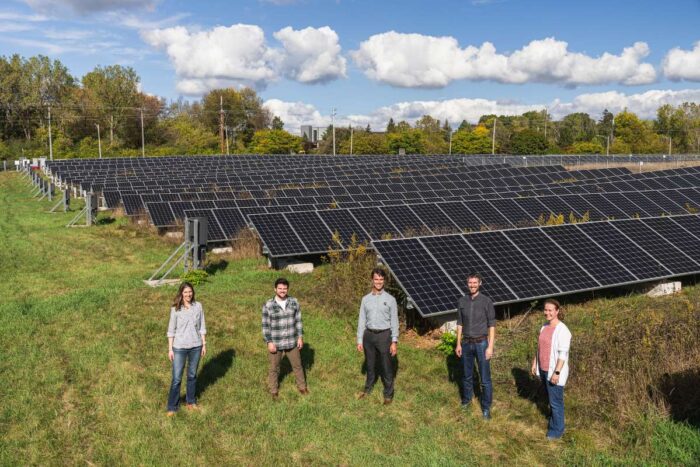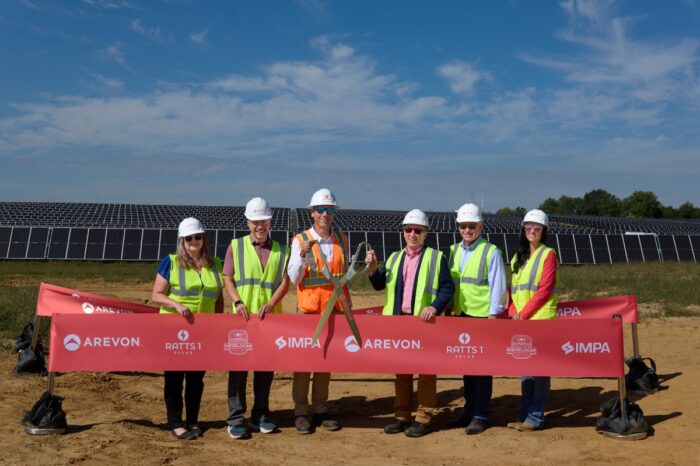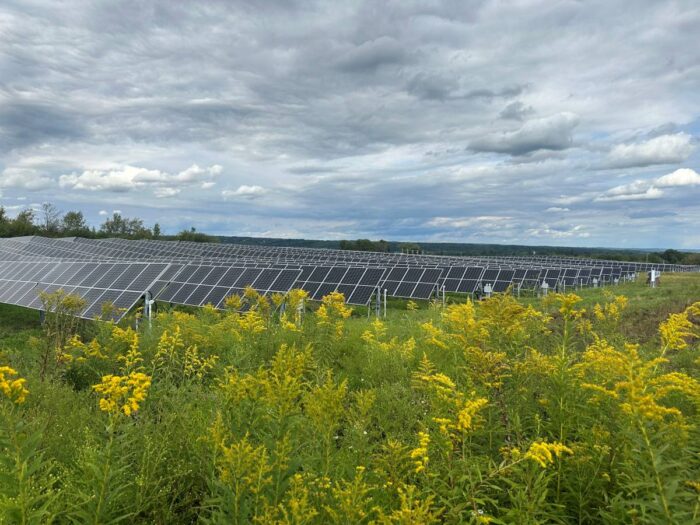Farming meets solar power at MSU | Projects Weekly

This edition of Projects Weekly kicks off with an initiative at Michigan State University to study how solar panels placed alongside farm crops could save water, improve soil health and support ecosystems. But wait, there’s more! Arevon has begun operations at two solar projects in Indiana, adding 264 MW of power to the grid. Everybody Solar completed a new 10.08-kW solar array and EV charging station at Cottonwood Gulch Expedition’s main offices in New Mexico. GS Power Partners has acquired a community solar project to advance education and biodiversity in Bethlehem, New York. CleanCapital has completed 3.59 MW brownfield solar project in Buffalo, New York. Standard Solar has acquired a 6.3 MW community solar project in Illinois from Calvert Energy. Nexamp has secured $600 million in financing from ATLAS SP Partners to accelerate distributed generation projects. Climate First Bank has financed two battery energy storage systems in Virginia.
Farming meets solar power in new MSU project

Michigan State University scientists plan to build a first-of-its-kind outdoor lab to study how solar panels placed alongside crops could save water, improve soil health and support ecosystems, all while boosting farmers’ bottom line and preserving farm production.
The project, led by Earth and Environmental Sciences Assistant Professor Anthony Kendall, is made possible by a five-year $3.6 million National Science Foundation grant. He and an interdisciplinary team will study existing solar parks to find out how the panels affect the soil and ecosystems surrounding them. Then, they’ll install a small array of 30 solar panels near corn and soybean fields to teach farmers, scientists and other stakeholders how to repurpose underproducing portions of their fields for solar energy.
The initial lab, set for the W.K. Kellogg Biological Station, or KBS, will be small, but the group envisions eventually building a world-class 15-acre facility. Bringing this concept to life will help farmers visualize what this method could look like in their fields and how it could make farming more sustainable as costs rise.
“There’s really nothing else like this,” Kendall said. “The experiments and education opportunities are crucial as solar energy becomes more widely used worldwide. This lab will help us teach farmers how they can harness energy from the sun to stabilize their income and ensure that they can keep producing crops for generations to come.”
Cool factor: With a background in hydrology, Kendall is also interested in studying how groundwater is affected by solar panels and how that impacts the soil moisture. He’s brought together a team of MSU scientists with unique expertise to ensure a cross-disciplinary perspective to this research, including:
- Annick Anctil, associate professor of civil and environmental engineering, who will create new metrics for quantifying the benefit of solar panels, incorporating not just the energy benefit but also savings in fertilizer, water and other effects on the ecosystem.
- Bruno Basso, Hannah Distinguished Professor of earth and environmental sciences and plant, soil and microbial sciences, who will use drones and remote sensing to help farmers pinpoint low productivity fields or large low-production areas within fields where they’re losing money due to high inputs and low commodity prices. Those areas could then be converted to solar sites surrounded by crops, increasing revenue for farmers and ecosystems services for the community.
- Nick Haddad, professor of integrative biology and core faculty member in MSU’s Ecology, Evolution and Behavior Program, or EEB, who will determine how the solar plots could benefit the balance of plants, animals and microbes that keep the ecosystem healthy. He’ll use techniques such as planting goldenrod, black-eyed Susans, switchgrass and other native plants around solar panels. These plants attract bees, butterflies and insects that pollinate plants and improve crop yields.
- Phoebe Zarnetske, professor of integrative biology and core faculty member in EEB, who is also a principal investigator of the Spatial and Community Ecology Lab and director of the Institute for Biodiversity, Ecology, Evolution and Macrosystems. She will measure how solar panels affect the plants and animals that call a field home.
- Adam Zwickle, associate professor and graduate program director of the Department of Community Sustainability, who will seek to understand farmer and community needs for agri-solar data and ways to incorporate personal and community values into the solar decision-making process.
The solar project comes as renewable energy surges worldwide. For the first time ever, solar, wind and other renewable energy sources generated more electricity than coal in the first six months of this year, according to an energy think tank report published in October.
Arevon energizes Ratts 1 and Heirloom solar projects in Indiana

Arevon Energy Inc. hosted a ribbon-cutting ceremony to celebrate the start of operations at its Ratts 1 and Heirloom Solar projects in Pike County, Indiana. Together, the projects add 264 MWdc of new domestic solar power to the grid and are the company’s first owned and operational utility-scale projects in the Hoosier State.
“Ratts 1 and Heirloom are about more than megawatts. They are tangible illustrations of the positive and real impact renewable energy can bring to local communities,” said Kevin Smith, CEO at Arevon. “These facilities will produce American-made power for decades, while also supporting Pike County’s economy and quality of life. Arevon is proud to be a long-term partner here, as we continue to invest in Indiana’s future.”
Cool factor: Ratts 1 and Heirloom represent an investment of nearly $400 million and will disburse more than $86 million to local governments over their lifespans, supporting schools, infrastructure, and other essential public services. The two facilities employed more than 200 full-time equivalent personnel to build the projects and also brought about an increase in spending at local stores, hotels, and restaurants. Ratts 1 Solar is under a long-term power purchase agreement with Indiana Municipal Power Agency (IMPA), and Meta is the offtaker for Heirloom Solar.
“Our county’s legacy in energy production is strong, and now we’re building on that foundation,” said Jill Hyneman, executive director at Pike County Chamber of Commerce. “By welcoming solar investment, Pike County is showing that honoring our past and investing in our future can go hand-in-hand in strengthening our economy, our schools, and our community for generations to come.”
Cottonwood Gulch Expeditions adds rooftop solar and EV charging station

Cottonwood Gulch Expeditions and Everybody Solar recently celebrated the successful completion of a new 10.08 kW solar array and EV charging station at Cottonwood Gulch’s main offices in Albuquerque, New Mexico.
“Supporting Cottonwood Gulch’s mission aligns perfectly with ours,” said Myriam Scally, executive director of Everybody Solar. “Each solar project we install not only cuts emissions but also strengthens the capacity of nonprofits like Cottonwood Gulch to inspire the next generation of environmental leaders.”
This project builds on the success of the 2019 collaboration between the two organizations, which brought 8.85 kW of solar energy to Cottonwood Gulch’s historic basecamp. That earlier system has already offset more than 17,000 pounds of carbon emissions and continues to help fund scholarships and expand access to outdoor learning opportunities.
Cool factor: The new solar system now offsets 100% of the Cottonwood Gulch’s electricity use at its headquarters, eliminating utility costs and reducing carbon emissions while serving as a real-world teaching tool for youth participating in the organization’s outdoor programs. The newly installed EV charger will also support plans to transition to an electric vehicle fleet in the near future.
“This new array and charging station are tangible steps toward a more sustainable future,” said Jordan Stone, executive director of Cottonwood Gulch Expeditions, which provides outdoor learning experiences for young people to connect with the natural world. “They allow us to model environmental stewardship for the youth we serve and strengthen our ability to provide accessible, hands-on outdoor education.”
GSPP acquires bee-friendly community solar project in New York

GS Power Partners (GSPP) has acquired the Hof Community Solar Project from the project’s developer, Eden Renewables. The community solar garden in Bethlehem, New York, not only delivers renewable energy to the region, but it also protects biodiversity and helps to support local education initiatives. GSPP plans to advance the Hof Project into construction with commercial operations expected in 2026.
“The Hof Project represents more than a single development. It reflects our long-term strategy to invest in renewable assets that deliver lasting value for communities and the grid,” said Jason Kuflik, CEO and cofounder of GS Power Partners. “By combining clean power generation with ecological stewardship and educational initiatives, this acquisition reinforces our commitment to scaling sustainable energy solutions that create both environmental impact and community benefit.”
Cool factor: The Hof Project integrates ecological stewardship with clean energy production. It will feature a pollinator-friendly habitat and ongoing biodiversity monitoring, creating a refuge for wildlife and contributing to the health of the local environment. This ensures ecological vitality while also powering approximately 1,225 households annually with renewable energy.
Education is also at the heart of the project’s mission as GSPP will build on Eden Renewables’ strong community engagement. Eden Renewables will continue to deliver its Eden Education Program, supporting STEAM scholarships and providing renewable energy curriculum resources for local schools. Students will have access to hands-on learning opportunities that connect science, technology, engineering, arts, and math with real-world sustainability, inspiring the next generation of innovators and environmental stewards.
CleanCapital completes 3.59 MW brownfield solar project in Buffalo
CleanCapital has begun commercial operations at its newest solar project located on Elk Street in downtown Buffalo, New York. The 3.59 MW Elk Street solar project illustrates CleanCapital’s brownfield development expertise and the company’s ongoing commitment to distributed energy generation and the revitalization of underutilized land.
“CleanCapital is excited to bring the Elk Street Solar project online and to continue our investment in distributed generation and brownfield development,” said Paul Curran, chief development officer at CleanCapital. “This project exemplifies how solar energy can make a local impact for communities, support grid resiliency, and deliver real benefits to residents of Buffalo.”
Cool factor: Situated just north of the Buffalo River on an 11-acre site formerly used as part of an ExxonMobil tank farm, the solar project transforms a capped and lined brownfield adjacent to a water treatment facility into a productive energy asset for the City of Buffalo. The project is projected to produce over 4,100 MWh annually and contribute meaningfully to New York’s long-term clean energy goals. The site will deliver affordable solar energy to local residents—including low- and moderate-income households—through the National Grid’s Expanded Solar for All (E-SFA) program.
The Elk Street Solar project is part of CleanCapital’s West Elk Fork (WEF) portfolio, joining two other New York-based projects—West Shore in West Park and Fork in the Road in Milan. All three projects provide renewable energy to National Grid customers, enhancing grid reliability, stabilizing energy pricing, and expanding access to community solar across New York.
Standard Solar acquires 6.3 MW community solar project in Illinois
Standard Solar has acquired the 6.3 MW Plaines II West Community Solar Garden in Channahon, Illinois, from Calvert Energy. Located on Amoco Road in Channahon, the single-axis tracker array is expected to generate approximately 9,944 MWh of renewable energy in its first year of operation.
“Having secured a large inventory of safe-harbored panels, we’re able to move projects like Plaines II West quickly from acquisition to operation,” said John Finnerty, director of business development at Standard Solar. “That ability to act fast turns development opportunities into operating assets sooner, delivering reliable clean energy and measurable value for our partners and communities nationwide.”
Cool factor: The acquisition builds on Standard Solar’s growing community solar portfolio in Illinois, which now includes more than a dozen projects totaling more than 30 MW across the state. Nationwide, the company’s community solar portfolio totals nearly 500 MW of owned, operating and under construction projects—underscoring its scale, expertise and long-term commitment to expanding clean energy access through efficient, accelerated project execution.
Calvert Energy developed the Plaines II West project, and Standard Solar will own and operate it long-term, ensuring sustained economic and environmental benefits for the region. Residents and businesses in the area can subscribe to the project and lower their electricity bills without needing to install solar panels on their property.
Nexamp secures $600 million for DG project development
Nexamp has closed on a $600 million aggregation facility with ATLAS SP Partners. The funding agreement will support the construction of Nexamp’s growing portfolio of distributed solar and energy storage projects across the United States.
The facility enables Nexamp to efficiently fund projects at the start of construction, with the flexibility to term-convert within the structure. Once a critical mass of operating assets is achieved, the company plans to pursue an asset-backed securitization (ABS) takeout, continuing its strategy of building scalable, capital-efficient pathways to expand clean energy access.
Cool factor: With the ATLAS facility in place, Nexamp is positioned to accelerate the build-out of new solar and storage capacity nationwide, advancing its mission to make clean energy simple and accessible for all.
“This partnership with ATLAS underscores the strength of Nexamp’s platform and the maturity of distributed energy as an investable asset class,” said Zaid Ashai, CEO of Nexamp. “As energy demand surges nationwide, solar has proven to be the most cost-effective and fastest-to-deploy resource available today. This facility ensures that Nexamp can continue to deliver the reliable, clean power that communities and businesses need now.”
Climate First Bank finances 2 BESS projects in Virginia
Climate First Bank has financed two, utility-scale battery energy storage systems, delivering a total of 20 MW of power and 80 MWh of storage, located along Virginia’s eastern shore.
Developed by Patterson Enterprises in partnership with battery manufacturer, Great Power, the investment will provide a major boost to the region’s grid resilience and community sustainability in the towns of Exmore and Tasley.
Cool factor: The projects support Virginia’s Clean Economy Act goal of 100% renewable energy by 2050 and monetizes through energy arbitrage, storing electricity when supply is abundant and releasing it during peak demand.
“These projects mark a significant milestone in sustainable infrastructure in the region, stabilizing energy costs, supporting local investment, and advancing clean energy goals,” said Chris Cucci, chief strategy officer at Climate First Bank. “ We remain committed to financing climate-resilient infrastructure that benefits communities economically and environmentally and are proud to support reliable energy for the Eastern Shore.”




